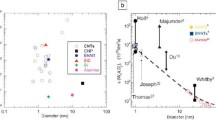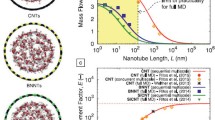Abstract
Extremely rapid water flow through carbon nanotubes has been observed in both experiment and simulation which has led to the suggestion that this material be used in a number of filtration applications. However, there is significant disparity in the magnitude of water permeability and the degree of flow enhancement compared with conventional porous materials in the literature. Here, we show that one of the causes of the disparity in simulation data is the variety of methods used to control temperature in molecular simulations. Not only can the choice of thermostat alter the flow rate and permeability by as much as five times, but it can determine whether the transport is observed to be frictionless or not. In addition to helping explain the disparate simulation results on transport in nanomaterials, this work provides some guidelines to help designing and interpreting molecular simulations of mass transport.


Similar content being viewed by others
References
Andersen HC (1980) Molecular-dynamics simulations at constant pressure and-or temperature. J Chem Phys 72:2384–2393
Basconi JE, Shirts MR (2013) Effects of temperature control algorithms on transport properties and kinetics in molecular dynamics simulations. J Chem Theory Comput 9:2887–2899
Berendsen HJC, Postma JPM, Vangunsteren WF, Dinola A, Haak JR (1984) Molecular-dynamics with coupling to an external bath. J Chem Phys 81:3684–3690
Cohen-Tanugi D, Grossman JC (2012) Water desalination across nanoporous graphene. Nano Lett 12:3602–3608
Corry B (2008) Designing carbon nanotube membranes for efficient water desalination. J Phys Chem B 112:1427–1434
Corry B (2011) Water and ion transport through functionalised carbon nanotubes: implications for desalination technology. Energ Environ Sci 4:751–759
Gong XJ, Li JY, Zhang H, Wan RZ, Lu HJ, Wang S, Fang HP (2008) Enhancement of water permeation across a nanochannel by the structure outside the channel. Phys Rev Lett 101:257801
Gong XJ, Li JC, Xu K, Wang JF, Yang H (2010) A controllable molecular Sieve for Na+ and K+ ions. J Am Chem Soc 132:1873–1877
Groot RD, Warren PB (1997) Dissipative particle dynamics: bridging the gap between atomistic and mesoscopic simulation. J Chem Phys 107:4423–4435
Hilder TA, Gordon D, Chung SH (2009) Salt rejection and water transport through boron nitride nanotubes. Small 5:2183–2190
Hilder TA, Yang R, Ganesh V, Gordon D, Bliznyuk A, Rendell AP, Chung SH (2010) Validity of current force fields for simulations on boron nitride nanotubes. Micro Nano Lett 5:150–156
Holt JK, Park HG, Wang YM, Stadermann M, Artyukhin AB, Grigoropoulos CP, Noy A, Bakajin O (2006) Fast mass transport through sub-2-nanometer carbon nanotubes. Science 312:1034–1037
Hoover WG (1985) Canonical dynamics—equilibrium phase-space distributions. Phys Rev A 31:1695–1697
Hummer G, Rasaiah JC, Noworyta JP (2001) Water conduction through the hydrophobic channel of a carbon nanotube. Nature 414:188–190
Hunenberger P (2005) Thermostat algorithms for molecular dynamics simulations. Adv Polym Sci 173:105–147
Joseph S, Aluru NR (2008) Why are carbon nanotubes fast transporters of water? Nano Lett 8:452–458
Kalra A, Garde S, Hummer G (2003) Osmotic water transport through carbon nanotube membranes. P Natl Acad Sci USA 100:10175–10180
Kannam SK, Todd BD, Hansen JS, Daivis PJ (2013) How fast does water flow in carbon nanotubes? J Chem Phys 138:094701
Khademi M, Sahimi M (2011) Molecular dynamics simulation of pressure-driven water flow in silicon-carbide nanotubes. J Chem Phys 135:204509
Koopman EA, Lowe CP (2006) Advantages of a Lowe–Andersen thermostat in molecular dynamics simulations. J Chem Phys 124:204103
Krishnan TVS, Babu JS, Sathian SP (2013) A molecular dynamics study on the effect of thermostat selection on the physical behaviour of water molecules inside single walled carbon nanotubes. J Mol Liq 188:42–48
Li PH, Lim XD, Zhu YW, Yu T, Ong CK, Shen ZX, Wee ATS, Sow CH (2007) Tailoring wettability change on aligned and patterned carbon nanotube films for selective assembly. J Phys Chem B 111:1672–1678
Liu HM, Murad S, Jameson CJ (2006) Ion permeation dynamics in carbon nanotubes. J Chem Phys 125:084713
Majumder M, Corry B (2011) Anomalous decline of water transport in covalently modified carbon nanotube membranes. Chem Commun 47:7683–7685
Majumder M, Chopra N, Andrews R, Hinds BJ (2005) Nanoscale hydrodynamics: enhanced flow in carbon nanotubes (vol 438, p 44, 2005). Nature 438:930
Mark P, Nilsson L (2001) Structure and dynamics of the TIP3P, SPC, and SPC/E water models at 298 K. J Phys Chem A 105:9954–9960
Nicholls WD, Borg MK, Lockerby DA, Reese JM (2012a) Water transport through (7,7) carbon nanotubes of different lengths using molecular dynamics. Microfluid Nanofluid 12:257–264
Nicholls WD, Borg MK, Lockerby DA, Reese JM (2012b) Water transport through carbon nanotubes with defects. Mol Simulat 38:781–785
Nose S (1984) A unified formulation of the constant temperature molecular-dynamics methods. J Chem Phys 81:511–519
Peter C, Hummer G (2005) Ion transport through membrane-spanning nanopores studied by molecular dynamics simulations and continuum electrostatics calculations. Biophys J 89:2222–2234
Ritos K, Mattia D, Calabro F, Reese JM (2014) Flow enhancement in nanotubes of different materials and lengths. J Chem Phys 140:014702
Rosta E, Buchete NV, Hummer G (2009) Thermostat artifacts in replica exchange molecular dynamics simulations. J Chem Theory Comput 5:1393–1399
Song C, Corry B (2009) Intrinsic ion selectivity of narrow hydrophobic pores. J Phys Chem B 113:7642–7649
Stoyanov SD, Groot RD (2005) From molecular dynamics to hydrodynamics: a novel Galilean invariant thermostat. J Chem Phys 122:114112
Su JY, Guo HX (2012) Effect of nanochannel dimension on the transport of water molecules. J Phys Chem B 116:5925–5932
Suk ME, Raghunathan AV, Aluru NR (2008) Fast reverse osmosis using boron nitride and carbon nanotubes. Appl Phys Lett 92:133120
Thomas JA, McGaughey AJH (2008) Reassessing fast water transport through carbon nanotubes. Nano Lett 8:2788–2793
Thomas JA, McGaughey AJH, Kuter-Arnebeck O (2010) Pressure-driven water flow through carbon nanotubes: insights from molecular dynamics simulation. Int J Therm Sci 49:281–289
Won CY, Aluru NR (2007) Water permeation through a subnanometer boron nitride nanotube. J Am Chem Soc 129:2748–2749
Won CY, Aluru NR (2008) Structure and dynamics of water confined in a boron nitride nanotube. J Phys Chem C 112:1812–1818
Won CY, Joseph S, Aluru NR (2006) Effect of quantum partial charges on the structure and dynamics of water in single-walled carbon nanotubes. J Chem Phys 125:114701
Zhu FQ, Schulten K (2003) Water and proton conduction through carbon nanotubes as models for biological channels. Biophys J 85:236–244
Author information
Authors and Affiliations
Corresponding author
Electronic supplementary material
Below is the link to the electronic supplementary material.
Rights and permissions
About this article
Cite this article
Thomas, M., Corry, B. Thermostat choice significantly influences water flow rates in molecular dynamics studies of carbon nanotubes. Microfluid Nanofluid 18, 41–47 (2015). https://doi.org/10.1007/s10404-014-1406-y
Received:
Accepted:
Published:
Issue Date:
DOI: https://doi.org/10.1007/s10404-014-1406-y




